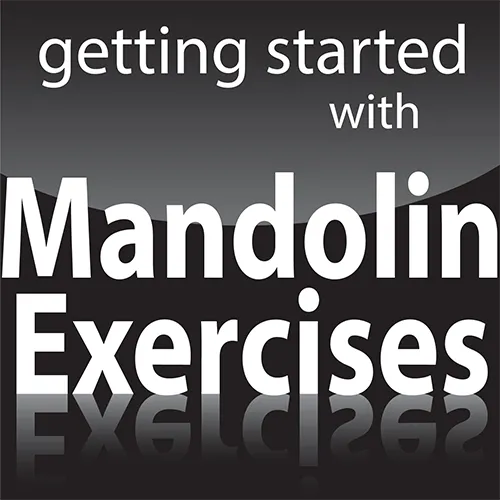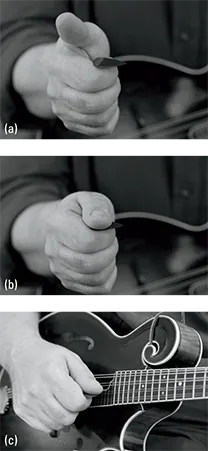Chapter 1
Getting the Basics Sorted: Mandolin Fundamentals
In This Chapter
Checking out right-hand fundamentals
Using your left hand effectively
You can’t play the mandolin without using your hands and fingers. So in this chapter I run through the left- and right-hand basics (check out Mandolin For Dummies for more details). I take the opportunity to cover the following: holding the pick, basic picking techniques, left-hand fingerings, and proper left-hand grip. I also include reading tablature, chord diagrams, and neck diagrams.
If you already know some of this material, taking a second look never hurts. Reminding yourself is usually good, unless of course it’s a reminder about how awful it feels to trip over and put your foot through your favorite mandolin!
Tuning Up
Before you can make beautiful music on your mandolin, you need to be in tune. Listen to Track 1 of the downloadable audio tracks (
www.dummies.com/go/mandolinexercises) and tune to me if you like to tune by ear, or use your favorite tuning method. For further information on a variety of tuning methods be sure to have a flick through
Mandolin For Dummies.
Covering a Few Right-Hand Basics
One of the most important elements in mandolin playing is having a strong, co-ordinated, and organized right hand. This hand is responsible for rhythm, tone, dynamics, and speed. It needs to stay relaxed and loose while you’re playing. Small adjustments in the way you hold the pick can dramatically change your tone or even your ability to play at faster tempos. (I give you tips on speeding up in Chapter 16.)
Another often-overlooked part of mandolin playing is maintaining proper pick direction. Many of the exercises in this book include elements that deal with pick direction to help strengthen and develop your left and right hands.
Holding the pick
Beginners often pass over this basic skill, but sooner or later you need to come to grips with the way you hold your pick:
- Make your right hand a loose fist with your thumb sticking up a bit.
- Lay the pick on the side of your first finger, as shown in Figure 1-1 (a).
- Place your thumb over the pick so that you’re holding the pick between the pad of your thumb and the side of your index finger (b).
- Hold the pick as loosely as you can.
A death grip may be great for subduing aggressive Klingons, but it’s no good for playing the mandolin. Too tight a grip on your pick guarantees bad tone and uneven tremolo, and may even get you thinking that you’ll never be able to play quickly.
- Position your right hand so that the pick hits the strings somewhere near the end of the fingerboard. (This is often called the ‘Sweet Spot’.)
Some players support their right hand by lightly touching the bridge with the heel of the right hand. Some don’t touch the bridge but support their right hand by dragging their third and fourth fingers on the top of the mandolin or the pick guard (which is sometimes called the finger rest). Some believe that you shouldn’t touch the top of the mandolin at all. What all players can agree on, however, is to support the mandolin by resting your arm on the rib as shown in Figure 1-1 (c).
For more details of picks, holding the pick, and methods of support for the right hand, see Chapter 5 of Mandolin For Dummies.
Getting up to speed with alternate picking
If you had to pick one technique that defines mandolin playing it would be alternate picking. Alternate picking in its simplest form is just a series of pick strokes following an even down-up, down-up pattern. Mastering this technique is essential to playing certain popular mandolin styles such as fiddle tunes, rags, bluegrass, swing, choro, Bach, and any music that has a steady, even flow of notes.
Tremolo is a well known mandolin technique based on alternate picking. Owing to the lack of sustain when playing a mandolin, mandolin players over the years have developed the tremolo, which is basically rapid alternate picking to imitate the continuous sustained sound of the violin bow.
See the following exercise for a basic set of alternate-picking drills. Many of the scale and arpeggio exercises I present in this book (see the chapters in Parts
II and
III, respectively) require a decent understanding of alternate picking. You can consider the following figure (which I demonstrate on Track 2) to be a test. If you’re prepared to work through the exercises in this book, you can perform these four types of alternate picking: (a) eighth notes (quavers), (b) eighth-note triplets, (c) sixteenth notes (semiquavers), and (d) sixteenth-note triplets.
If you’re struggling a bit with these alternate-picking drills, visit Chapter
5 of
Mandolin For Dummies, where I describe alternate picking and tremolo in more detail.
Letting Your Left Hand Do the Talking
The left hand is responsible for making the actual note pitches, as well as ornaments including different types of slurs that connect notes together smoothly. Position shifts (playing in different regions up and down the neck) require a good understanding of a variety of left-hand fingerings.
Clarity and sustain require clean fretting of each and every note, which can happen only when you understand proper left-hand technique. If you aren’t 100 per cent confident with your left-hand skills, take a look at Chapter
6 of
Mandolin For Dummies. I describe some useful finger warm-up exercises and techniques for you in Chapter 2.
Using a proper grip
Here are a few pointers for getting the most out of your left hand:
- Support the neck with your t...










